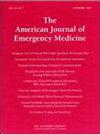椎旁筋膜平面阻滞:超声引导下治疗椎旁颈背部疼痛的新技术
IF 2.2
3区 医学
Q1 EMERGENCY MEDICINE
引用次数: 0
摘要
椎旁肌筋膜疼痛综合征(MPS)是急诊科(ED)就诊的常见原因,但现有的治疗方法往往提供不完全或短暂的缓解。越来越多的证据表明筋膜是MPS疼痛的关键驱动因素,支持有针对性的界面干预。方法:我们对2024年9月1日至2025年8月31日期间接受超声引导下椎旁筋膜平面阻滞(pffb)治疗的成人ED患者进行了单中心回顾性观察队列研究。符合条件的患者表现为与MPS一致的局灶性颈椎、胸椎或腰椎椎旁疼痛,并且对ED镇痛药反应不足或有难治性椎旁MPS病史。pffb手术由两部分组成:(1)在棘旁肌之间的筋膜平面内注射麻醉剂、生理盐水和地塞米松的组合;(2)肌肉筋膜的针刺。数值评定量表(NRS)疼痛评分记录在阻滞前基线、ED出院和24 - 48小时随访时用于临床护理目的。结果16例患者(中位年龄48岁,64%为女性)行PFPB。NRS疼痛评分中位数从阻滞前的9/10(四分位数范围[IQR] 8-9)降至出院时的3/10 (IQR 0-4),差异有统计学意义(n = 11, p = 0.004)。在24-48小时(n = 10),中位疼痛评分为1/10 (IQR 0-2.75), 80%报告相对于出院持续或改善缓解。无并发症发生,治疗的患者在初次出院后48小时内没有返回我们卫生系统的急诊室。结论PFPB可快速、持续地减轻难治性椎旁MPS患者的疼痛。这些初步发现支持进一步的前瞻性研究,以验证PFPB的有效性,并为其在急诊护理中的实施提供信息。本文章由计算机程序翻译,如有差异,请以英文原文为准。
The paravertebral fascial plane block: A novel, ultrasound-guided technique for paraspinal neck and back pain
Introduction
Paraspinal myofascial pain syndrome (MPS) is a common cause of emergency department (ED) visits, but existing therapies often provide incomplete or short-lived relief. Increasing evidence implicates the fascia as a key driver of the pain in MPS, supporting targeted interfascial interventions.
Methods
We conducted a single-center retrospective observational cohort study of adult ED patients who received a novel, ultrasound-guided paravertebral fascial plane block (PFPB) between September 1, 2024 – August 31, 2025. Eligible patients presented with focal cervical, thoracic, or lumbar paraspinal pain consistent with MPS and had either inadequate response to ED analgesics or a history of refractory paraspinal MPS. The PFPB procedure consisted of two components: (1) injection of a combination of anesthetic, normal saline, and dexamethasone within the fascial planes between the paraspinal muscles, and (2) needling of the muscular fasciae. Numeric Rating Scale (NRS) pain scores were documented for clinical care purposes at pre-block baseline, ED discharge, and 24–48-h follow-up.
Results
Eleven patients (median age 48 years, 64 % female) underwent the PFPB. Median NRS pain score decreased significantly from 9/10 (interquartile range [IQR] 8–9) pre-block to 3/10 (IQR 0–4) at discharge (n = 11, p = 0.004). At 24–48 h (n = 10), the median pain score was 1/10 (IQR 0–2.75), with 80 % reporting sustained or improved relief relative to discharge. No complications occurred, and none of the treated patients returned to any of our health system's EDs within 48 h following initial discharge.
Conclusions
The PFPB provided rapid and sustained pain reduction for ED patients with intractable paraspinal MPS. These preliminary findings support further prospective studies to validate the PFPB's efficacy and inform its implementation in emergency care.
求助全文
通过发布文献求助,成功后即可免费获取论文全文。
去求助
来源期刊
CiteScore
6.00
自引率
5.60%
发文量
730
审稿时长
42 days
期刊介绍:
A distinctive blend of practicality and scholarliness makes the American Journal of Emergency Medicine a key source for information on emergency medical care. Covering all activities concerned with emergency medicine, it is the journal to turn to for information to help increase the ability to understand, recognize and treat emergency conditions. Issues contain clinical articles, case reports, review articles, editorials, international notes, book reviews and more.

 求助内容:
求助内容: 应助结果提醒方式:
应助结果提醒方式:


